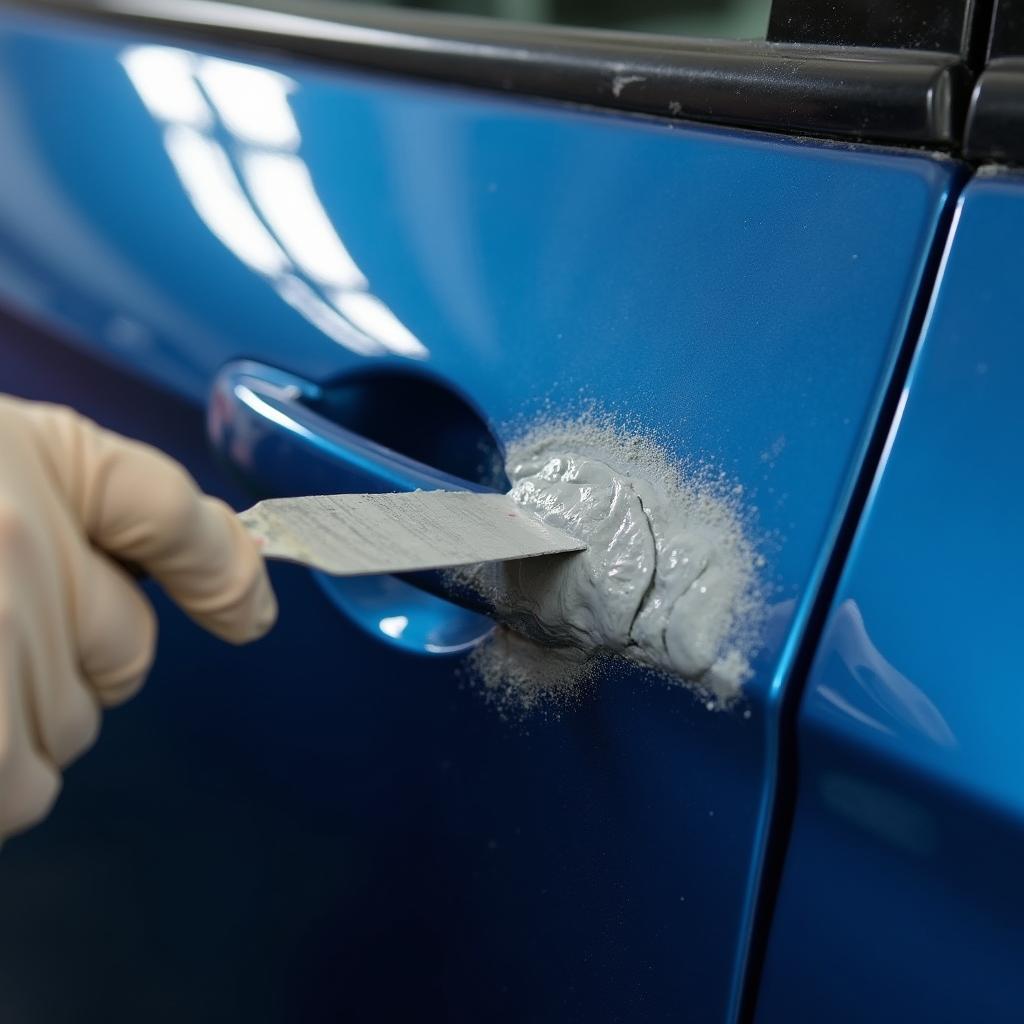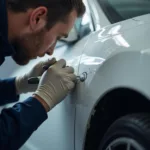Car body repair paste, also known as body filler or putty, is a versatile product designed to repair minor imperfections on car exteriors. It’s a valuable tool for both DIY enthusiasts and professional auto body shops, offering a cost-effective and efficient way to restore a vehicle’s smooth, flawless appearance.
Understanding Car Body Repair Paste
This type of paste is essentially a two-part compound consisting of a base resin and a hardener. When mixed, these components initiate a chemical reaction that causes the paste to harden and cure, forming a durable bond with the car’s metal surface.
Car body repair paste effectively fills in dents, scratches, and other surface imperfections, creating a smooth and level base for subsequent sanding and painting. It’s important to note that this paste is not a magical solution for severe damage; for deep dents or structural damage, professional repair is always recommended.
Choosing the Right Car Body Repair Paste
With numerous brands and formulations available, selecting the right car body repair paste for your needs might seem daunting. Here are some crucial factors to consider:
- Type of Damage: Different formulations cater to specific repair needs. For instance, lightweight fillers work best for minor scratches and imperfections, while heavy-duty pastes excel at filling deep dents.
- Drying Time: If you’re aiming for a quick fix, opt for a fast-drying paste. Keep in mind that faster drying often means less working time, so choose wisely based on your skill level and the complexity of the repair.
- Color: While most car body repair pastes come in a standard grey or beige, some manufacturers offer tinted versions to match common car colors. This can simplify the painting process, especially for DIY repairs.
Applying Car Body Repair Paste Like a Pro
Achieving a flawless finish with car body repair paste requires more than just slapping on the product. Here’s a step-by-step guide to ensure optimal results:
- Preparation is Key: Thoroughly clean the damaged area using soap and water, then dry it completely. For best adhesion, lightly sand the area with fine-grit sandpaper.
- Mixing Magic: Follow the manufacturer’s instructions carefully when mixing the base resin and hardener. Use a clean mixing board and putty knife to combine the components until you achieve a uniform color and consistency.
- Application Precision: Using a flexible putty knife, apply the mixed paste to the damaged area, working quickly as the paste starts to harden. Apply in thin, even layers, slightly overlapping each layer for optimal coverage.
- Sanding for Smoothness: Once the paste has fully cured (refer to the manufacturer’s instructions for drying time), begin sanding the area with coarse-grit sandpaper. Gradually progress to finer grits (300-400) until you achieve a perfectly smooth and level surface.
- Prime and Paint: Apply a primer specifically designed for auto body repair to seal the repaired area and promote paint adhesion. Once the primer dries, you can paint the area to match the rest of your car’s finish.
Common Car Body Repair Paste Mistakes to Avoid
Even seasoned DIY enthusiasts can fall prey to common pitfalls when using car body repair paste. Steering clear of these mistakes ensures a smooth and successful repair:
- Improper Mixing: Not mixing the components thoroughly or using inaccurate ratios can result in weak, uneven curing, compromising the repair’s durability.
- Applying Too Much Paste: While it might seem tempting to fill a deep dent with a single thick layer, this can lead to cracking, shrinking, and an uneven finish. Always apply in thin, multiple layers.
- Ignoring Drying Times: Impatience can ruin a perfectly good repair. Allow ample drying time between layers and before sanding to ensure the paste cures completely and forms a strong bond.
- Neglecting Surface Preparation: Skipping the cleaning and sanding steps can lead to poor adhesion, causing the paste to peel or flake off over time.
Conclusion
Car body repair paste offers a practical and affordable solution for tackling minor dents, scratches, and imperfections on your car’s exterior. By understanding the different types of paste, mastering the application techniques, and avoiding common mistakes, you can achieve professional-looking results and restore your car’s pristine appearance. Remember, for significant damage, always consult a qualified auto body repair professional.
Frequently Asked Questions (FAQs)
1. Can I use car body repair paste on plastic bumpers?
While car body repair paste is primarily designed for metal surfaces, some formulations are suitable for plastic bumpers. Ensure you choose a product specifically labeled for plastic repair.
2. How long does car body repair paste take to dry?
Drying time varies significantly depending on the product, ambient temperature, and humidity levels. Always refer to the manufacturer’s instructions for specific drying times.
3. Can I apply car body repair paste over existing paint?
It’s not recommended to apply car body repair paste directly over paint. For best adhesion, sand down to the bare metal before applying the paste.
4. Is car body repair paste waterproof?
Once cured and painted, car body repair paste is waterproof and resistant to most weather conditions.
5. Can I sand car body repair paste to achieve a smooth finish?
Yes, sanding is a crucial step in the car body repair process. Use progressively finer grit sandpaper to achieve a perfectly smooth and level surface before priming and painting.
Need more help with your car repairs?
For more information on car body repair, including detailed guides on various techniques and product recommendations, check out our comprehensive resource on car body repair with cataloy. We provide insightful articles and tutorials to empower both DIY enthusiasts and professional mechanics.
Need personalized assistance? Contact us via WhatsApp at +1(641)206-8880 or email us at [email protected]. Our dedicated customer support team is available 24/7 to answer your questions and offer expert advice.



